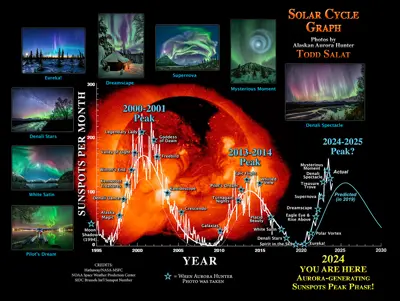Solar Cycle
The sun has a heartbeat. Every 10 or 12 years it beats, and it beats hard. This is known as the solar cycle and is measured by the number of sunspots visible on the sun. The more sunspots, the more solar flare energy is being released into space which means more aurora activity!
Q: Where are we now on the solar cycle?
A: Great News! We are in Solar Maximum, the Peak Phase. The higher number of sunspots means more solar activity which in turn means more aurora activity!
The accompanying graph shows how throughout time (horizontal axis) the number of sunspots per month (vertical axis) goes up & down. See the you are here in the lower right? That’s where we are right now on the timeline and the sunspot count is clearly in the Peak Phase. I’ve plotted some of my best aurora photos on this timeline and one thing I’ve learned in the past 30+ years of aurora hunting is there is no time like the present to get out there and get eyes on the sky.
Q: When is the best time to see the northern lights?
A: Between 11pm and 2am are the peak aurora hours but they can show up anytime from dusk until dawn. Some of the most colorful displays I've ever seen occurred in dawn's early twilight around 5am-7am.
Q: When should I plan my aurora hunt?
Statistically, the equinox months of September and March are the best for aurora activity but the winter months of October-thru-February are also good. In northern latitudes like Fairbanks, Alaska the summer months of May, June & July are too bright to see the aurora. It's challenging to pinpoint the exact timing of a big display. The best advice I can give is to be patient, diligent and pay close attention to the websites that monitor space weather then go for it when the timing seems right. Luck favors the prepared.
Historical Solar Cycle
Data courtesy:
SILSO data/image, Royal Observatory of Belgium, Brussels
online catalogue of the sunspot index: https://www.sidc.be/SILSO/home, ‘1750-2022’



